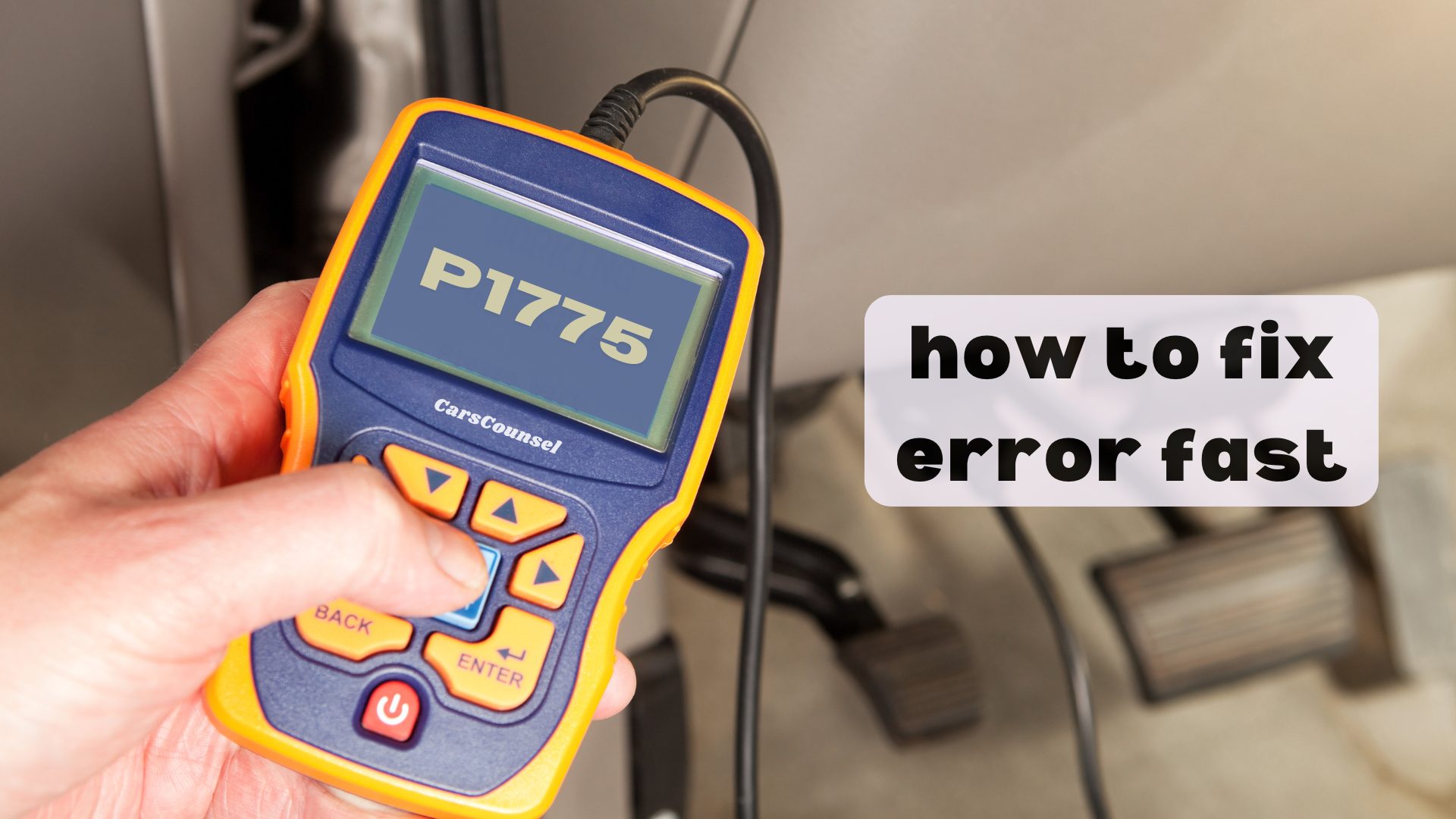If you see the P1775 code, you need to fix it quickly to avoid serious transmission problems and engine stalling.
First, check your transmission fluid; it could be low or dirty.
Use an OBD-II scanner to confirm the trouble code and then look at your wiring for any damage.
You should also test the solenoid valve’s resistance. If it’s faulty, you’ll need to replace it.
There are more steps and preventative measures you can take to ensure this issue doesn’t happen again.

Quick Navigation
Key Takeaways
- Make sure the transmission fluid is at the right level and in good condition.
- Use an OBD-II scanner to confirm the P1775 code and get data.
- Check the solenoid switch valve to see if it has the right resistance.
- Look over the wiring and connectors connected to the Transmission Control Module (TCM).
Understanding P1775 Code
In the world of car repairs, the P1775 code means there’s a problem with the solenoid switch valve, especially when it’s stuck in the ‘torque converter clutch (TCC) Off’ position.
Knowing what the P1775 code means is really important. When this valve gets stuck, the torque converter can’t work right. This means engine power isn’t getting to the transmission, which can cause your car to stall, wear out parts faster, and possibly damage the transmission.
To figure out what’s wrong, first check the transmission fluid level and condition. Then, use an OBD-II scanner to confirm the code and look at the solenoid switch valve and its wiring.
Getting the diagnosis right is key to fixing the problem efficiently.
Symptoms of P1775 Code
If your car has a P1775 code, you might notice the engine stalling when you stop, hesitation when you try to accelerate, poor gas mileage, and the check engine light turning on.
If the engine stalls when you stop, it means the torque converter clutch isn’t letting go properly.
If there’s hesitation when you accelerate, the solenoid switch valve may not be working right.
Poor fuel economy happens because the transmission isn’t running efficiently.
The check engine light means you need to check things out right away.
Use an OBD-II scanner to confirm the P1775 code and then inspect further to find the exact problem.
Fixing these issues quickly can help avoid more damage to your transmission.
Common Causes
A P1775 code usually happens because of a bad solenoid switch valve, but it can also be caused by low transmission fluid, dirty fluid, or electrical problems.
If the solenoid switch valve isn’t working right, it can mess up how the torque converter clutch works, which leads to transmission issues.
Dirty or old transmission fluid can also cause this error because it makes the system work poorly. Make sure to check for low transmission fluid, as not having enough can mess with the valve’s operation.
Electrical problems, like damaged wires or bad connections, can also make the solenoid malfunction.
Affected Car Models
Certain car models are more likely to have problems with the P1775 code, especially Chrysler and Dodge vehicles, which often have issues with their solenoid switch valves. Nissan and Honda cars, like the Altima and Accord, also face similar issues with their solenoid valve control circuits. Hyundai Elantras can have these problems too, leading to stalling and poor transmission performance.
Here’s a quick guide to the common issues by model:
| Model | Common Problem | Symptom |
|---|---|---|
| Chrysler | Solenoid switch valve malfunction | Engine stalling |
| Dodge | Solenoid switch valve malfunction | Poor acceleration |
| Nissan Altima | Solenoid control circuit issues | Harsh shifting |
| Honda Accord | Solenoid control circuit problems | Transmission slipping |
These cars need to be checked quickly to avoid more serious transmission damage.
Initial Diagnostics
To start diagnosing the P1775 code, first, check the transmission fluid level to make sure it’s sufficient and clean.
Use an OBD-II scanner to read the code and gather initial data.
Inspect the wiring and connectors linked to the transmission control module (TCM) for any issues.
Look at wiring diagrams to find any damaged connections.
Test the solenoid switch valve‘s resistance with a multimeter and compare the results with the manufacturer’s specs.
Check the performance of related sensors to ensure they’re working correctly.
If you find any problems, make a note of them for further investigation.
These steps will help you figure out what’s causing the P1775 code and guide you on what to do next.
Checking Transmission Fluid
First, make sure the transmission fluid is at the right level and is clean. Low or dirty fluid can cause the P1775 code.
To check, find the transmission dipstick, usually located near the engine. Pull it out, wipe it clean, put it back in, then pull it out again to check the level. The fluid should be between the ‘Full’ and ‘Add’ marks.
Look at the fluid’s color and feel its texture; it should be a clear red without any burnt smell or particles. If it looks dark or smells burnt, change the fluid completely.
Keeping the fluid in good condition is key to a healthy transmission and can help prevent the P1775 code from coming back.
Electrical Inspections
When diagnosing the P1775 code, carefully check the vehicle’s electrical system, especially the wiring and connectors related to the transmission control module (TCM). Make sure the wiring is intact and the connectors are in good condition by looking for any signs of rust, damage, or loose connections. Use a multimeter to check voltage and continuity, making sure everything matches the manufacturer’s specifications. Here’s a simple guide to check the key parts:
| Part | What to Check For | Tools Needed |
|---|---|---|
| Wiring | Continuity, Damage | Multimeter, Visual |
| Connectors | Rust, Good Fit | Visual, Contact Cleaner |
| TCM Connections | Secure, Correct Voltage | Multimeter, Visual |
| Power Supply | Correct Voltage, Steady | Multimeter |
Follow these steps for a thorough electrical inspection to avoid incorrect diagnoses.
Testing Solenoid Valve
Start by using a multimeter to check the resistance of the solenoid valve and compare it to what the manufacturer recommends.
First, unplug the solenoid connector.
Then, set your multimeter to measure ohms.
Place the multimeter probes on the solenoid terminals to get a resistance reading.
If the reading is outside the recommended range, it means the solenoid isn’t working properly.
This test helps you find out if the solenoid is functioning correctly.
If the resistance isn’t as specified, the solenoid might be bad and need replacing.
Make sure all connections are tight before finishing the test.
This step is crucial for accurate diagnostics and avoiding further transmission problems related to the P1775 code.
Repair Solutions
Repair Solutions
When dealing with the P1775 code, you often need to replace the bad solenoid switch valve to get the transmission working right again. Start by making sure the solenoid replacement is done correctly. Then, take care of the fluid maintenance to prevent future problems.
| Task | Tools Needed | Key Steps |
|---|---|---|
| Replace Solenoid | Socket set, Multimeter | Remove the old solenoid, test it, and install the new one |
| Maintain Fluid Levels | Transmission fluid kit | Drain the old fluid, refill with new fluid, and check the levels |
| Fix Electrical Issues | Wiring diagrams, Tools | Inspect the wires, fix any issues, and secure them properly |
| Check Sensors | OBD-II Scanner | Scan for issues, test the sensors, and replace if needed |
| Get Professional Help | N/A | Consult an expert for a thorough diagnosis |
Make sure all repairs follow the manufacturer’s guidelines to ensure everything works correctly.
Preventative Measures
Regular transmission maintenance is key to preventing the P1775 code and ensuring your vehicle runs smoothly.
Make it a habit to check and change your transmission fluid regularly. Dirty or low fluid can mess up the solenoid switch valve, causing the code to appear. Always use the fluid recommended by the manufacturer to keep everything well-lubricated and free from debris.
Look over the transmission parts for any signs of wear. Pay special attention to the wiring and connectors, as electrical problems can affect how the solenoid works. Regularly check the sensors connected to the transmission control module (TCM) to make sure they’re working properly.
Stick to the manufacturer’s recommended transmission care schedule. Regular inspections and replacing faulty parts on time can prevent many issues.
These simple steps will help keep your transmission system running efficiently and reduce the chances of encountering errors like the P1775 code.
More OBD-II Codes
Frequently Asked Questions
Can Driving With a P1775 Code Damage My Transmission?
Driving with a P1775 code can harm your transmission and create driving hazards. It can cause more damage because the torque converter clutch isn’t working right. Stop driving, find out what’s wrong, and fix it right away to avoid expensive repairs.
How Long Does It Take to Fix the P1775 Code?
Fixing the P1775 code can take anywhere from 1 to 3 hours. The exact time depends on how long it takes to diagnose the issue, whether the parts are available, and how complicated the repair is. Always check with a professional to get an accurate estimate and proper repairs.
What Are the Costs Associated With Repairing a P1775 Code?
Fixing the P1775 code usually costs between $150 and $300. This covers parts like a solenoid switch valve and transmission fluid. Labor costs depend on how complicated the job is, generally ranging from $100 to $150 per hour.
Are There Temporary Fixes for the P1775 Code?
You can try short-term fixes like adding more transmission fluid if it’s low or resetting the car’s computer. These might help for now, but they won’t solve the problem for good. To fix it properly, you should see a professional mechanic for a full check-up and repairs.
Can I Diagnose the P1775 Code Without Professional Help?
Dive into the problem! You can figure out the P1775 code using tools like an OBD-II scanner. Check for usual signs like engine stalling and bad fuel economy. Also, make sure to check the wiring and fluid levels.
Conclusion
To sum it up, fixing the P1775 code isn’t as hard as it might seem.
Begin by checking the transmission fluid and then use your OBD-II scanner for more detailed diagnostics.
Look over the wiring and test the solenoid valve’s resistance. If you spot any problems, replace the solenoid right away.
Regular maintenance can help prevent future issues.
Follow these steps, and your vehicle will be running smoothly again soon.

